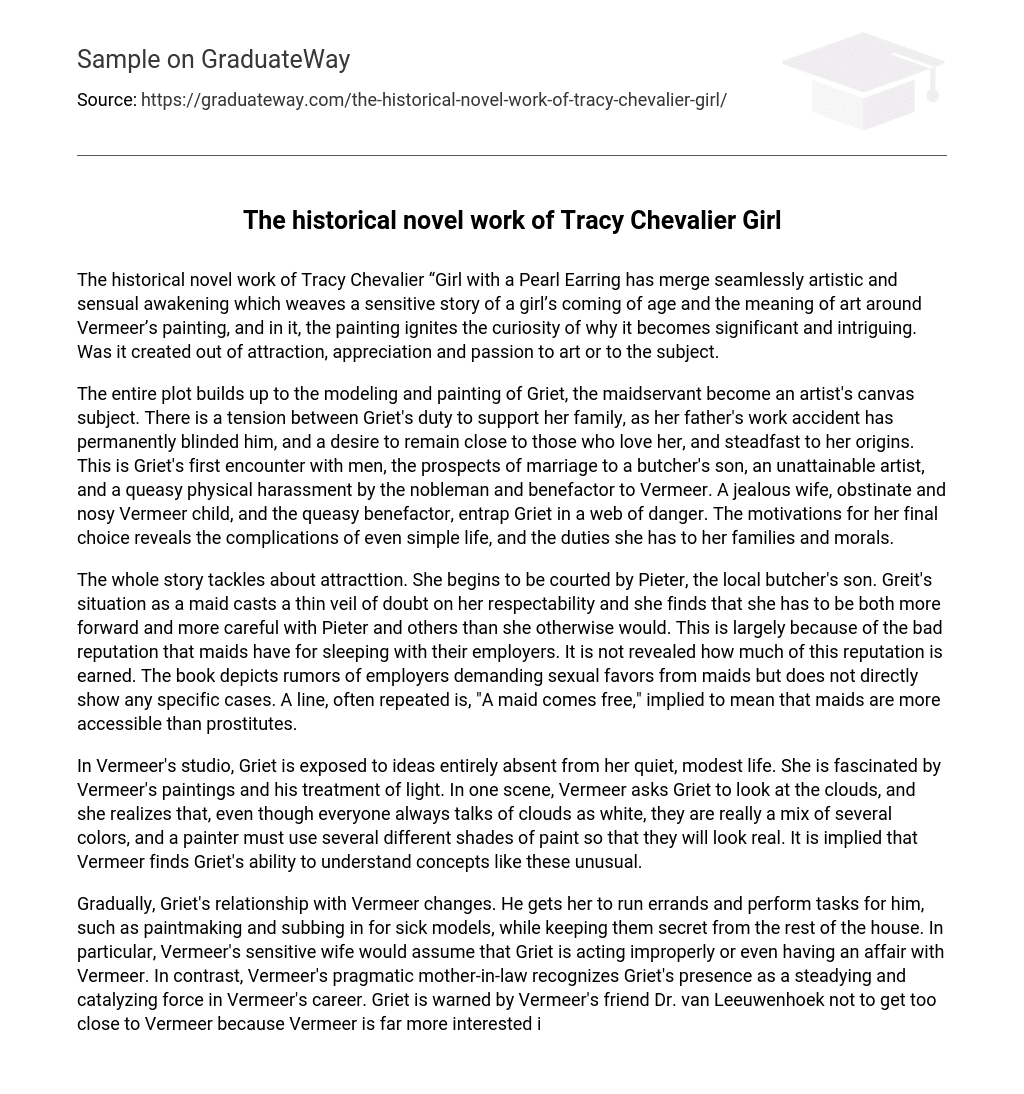The historical novel work of Tracy Chevalier “Girl with a Pearl Earring has merge seamlessly artistic and sensual awakening which weaves a sensitive story of a girl’s coming of age and the meaning of art around Vermeer’s painting, and in it, the painting ignites the curiosity of why it becomes significant and intriguing. Was it created out of attraction, appreciation and passion to art or to the subject.
The entire plot builds up to the modeling and painting of Griet, the maidservant become an artist’s canvas subject. There is a tension between Griet’s duty to support her family, as her father’s work accident has permanently blinded him, and a desire to remain close to those who love her, and steadfast to her origins. This is Griet’s first encounter with men, the prospects of marriage to a butcher’s son, an unattainable artist, and a queasy physical harassment by the nobleman and benefactor to Vermeer. A jealous wife, obstinate and nosy Vermeer child, and the queasy benefactor, entrap Griet in a web of danger. The motivations for her final choice reveals the complications of even simple life, and the duties she has to her families and morals.
The whole story tackles about attracttion. She begins to be courted by Pieter, the local butcher’s son. Greit’s situation as a maid casts a thin veil of doubt on her respectability and she finds that she has to be both more forward and more careful with Pieter and others than she otherwise would. This is largely because of the bad reputation that maids have for sleeping with their employers. It is not revealed how much of this reputation is earned. The book depicts rumors of employers demanding sexual favors from maids but does not directly show any specific cases. A line, often repeated is, “A maid comes free,” implied to mean that maids are more accessible than prostitutes.
In Vermeer’s studio, Griet is exposed to ideas entirely absent from her quiet, modest life. She is fascinated by Vermeer’s paintings and his treatment of light. In one scene, Vermeer asks Griet to look at the clouds, and she realizes that, even though everyone always talks of clouds as white, they are really a mix of several colors, and a painter must use several different shades of paint so that they will look real. It is implied that Vermeer finds Griet’s ability to understand concepts like these unusual.
Gradually, Griet’s relationship with Vermeer changes. He gets her to run errands and perform tasks for him, such as paintmaking and subbing in for sick models, while keeping them secret from the rest of the house. In particular, Vermeer’s sensitive wife would assume that Griet is acting improperly or even having an affair with Vermeer. In contrast, Vermeer’s pragmatic mother-in-law recognizes Griet’s presence as a steadying and catalyzing force in Vermeer’s career. Griet is warned by Vermeer’s friend Dr. van Leeuwenhoek not to get too close to Vermeer because Vermeer is far more interested in paintings than he is in people. Griet realizes that this is true and remains cautious.
At the same time, Vermeer’s wealthy but licentious patron, Van Ruijven, notices Griet and her beauty and begins to pressure Vermeer to paint them sitting together. Griet and Vermeer are reluctant to acquiesce, due to Griet’s strict modesty and a scandal surrounding the last girl who had been painted with van Ruijven. Eventually, Vermeer compromises and begins a painting Griet by herself, to be sold to van Ruijven. However, he tells her to wear his wife Catharina’s pearl earrings. When Catharina discovers this, Griet is forced to leave. Griet at first walks steadily out the front door, thinking, “Only thieves and children run.” Then she changes her mind and runs.
Greit do the right thing of leaving. Ten years later, long after Griet has married Pieter and settled into life as a mother and butcher’s wife, she is called back to the house. Vermeer is dead, and his will has been read. Griet assumes that Vermeer’s widow wishes to settle the household’s unpaid fifteen-guilder bill with the butcher shop. Pieter laughs and says that he didn’t mind losing the fifteen guilders because they bought him Griet as a wife. Tracy Chevalier evokes the life and customs of seventeenth century Delft in impressive detail. Vermeer himself remains in shadow, the private man and meticulous artist holding himself in check. Unable to permit herself the luxury of emotion, Griet becomes a silent, practical tradeswoman. Girl With a Pearl Earring is understated, as quiet and domestic as Vermeer’s art, but the more one looks at it, the more one sees.
Cited works
- “Girl with the pearl earring by Tracy Chevalier”.< http://www.allreaders.com>2007
- “Girl with the pearl earring by Tracy Chevalier” http://www.bookbrowse.com/reviews 2000





